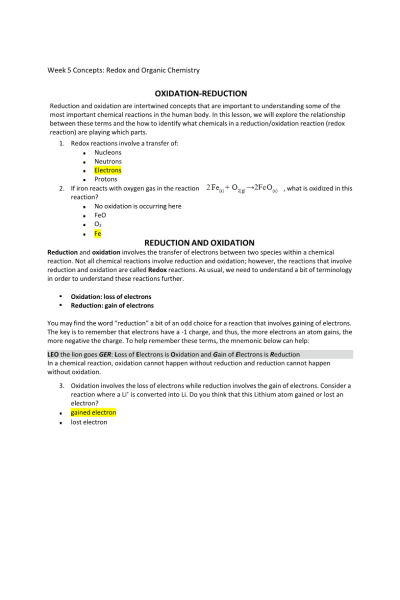CHEM 120 Week 5 Concepts; Redox and Organic Chemistry
-
$25.00
| Institution | Chamberlain |
| Contributor | Karin Austin |
Document Preview
OXIDATION-REDUCTION
Reduction and oxidation are intertwined concepts that are important to understanding some of the most important chemical reactions in the human body. In this lesson, we will explore the relationship between these terms and the how to identify what chemicals in a reduction/oxidation reaction (redox reaction) are playing which parts.
- Redox reactions involve a transfer of:
- Nucleons
- Neutrons
- Electrons
- Protons
- If iron reacts with oxygen gas in the reaction 2 Fe(s) + O2(g) →2Fe O(s) , what is oxidized in this
reaction?
- No oxidation is occurring here
- FeO
- O2
- Fe
REDUCTION AND OXIDATION
Reduction and oxidation involves the transfer of electrons between two species within a chemical reaction. Not all chemical reactions involve reduction and oxidation; however, the reactions that involve reduction and oxidation are called Redox reactions. As usual, we need to understand a bit of terminology in order to understand these reactions further.
- Oxidation: loss of electrons
- Reduction: gain of electrons
You may find the word “reduction” a bit of an odd choice for a reaction that involves gaining of electrons. The key is to remember that electrons have a -1 charge, and thus, the more electrons an atom gains, the more negative the charge. To help remember these terms, the mnemonic below can help:
LEO the lion goes GER: Loss of Electrons is Oxidation and Gain of Electrons is Reduction In a chemical reaction, oxidation cannot happen without reduction and reduction cannot happen without oxidation.
- Oxidation involves the loss of electrons while reduction involves the gain of electrons. Consider a reaction where a Li+ is converted into Li. Do you think that this Lithium atom gained or lost an electron?
- gained electron
- lost electron
IDENTIFYING OXIDATION AND REDUCTION
We know that electrons have a -1 charge, and we understand that +1 -1 = 0. So, if Li+ gains an electron, this is what cancels out the positive (+1) charge and makes this atom neutral……….. Continue
| Instituition / Term | |
| Term | Summer |
| Institution | Chamberlain |
| Contributor | Karin Austin |





-80x80.JPG)



-80x80.JPG)





























































